Are you a Quiet Speculation member?
If not, now is a perfect time to join up! Our powerful tools, breaking-news analysis, and exclusive Discord channel will make sure you stay up to date and ahead of the curve.
Welcome to the MTGO Market Report as compiled by Matthew Lewis. The report will cover a range of topics, including a summary of set prices and price changes for redeemable sets, a look at the major trends in various Constructed formats and a "Trade of the Week" section that highlights a particular speculative strategy with an example and accompanying explanation.
As always, speculators should take into account their own budgets, risk tolerances and current portfolios before buying or selling any digital objects. Please send questions via private message or post below in the article comments.
Redemption
Below are the total set prices for all redeemable sets on MTGO. All prices are current as of November 20, 2017. The TCGplayer low and TCGplayer mid prices are the sum of each set's individual card prices on TCGplayer, either the low price or the mid price respectively.
All MTGO set prices this week are taken from GoatBot's website, and all weekly changes are now calculated relative to GoatBot's "full set" prices from the previous week. All monthly changes are also relative to the previous month's prices, taken from GoatBot's website at that time. Occasionally, full set prices are not available, and so estimated set prices are used instead. Although both Aether Revolt (AER) and Kaladesh (KLD) are no longer available for redemption, their prices will continue to be tracked while they are in Standard. This will be the last week that I'll track prices for Magic Origins (ORI) and Dragons of Tarkir (DTK) as both of these sets will no longer be available for redemption after November 22.
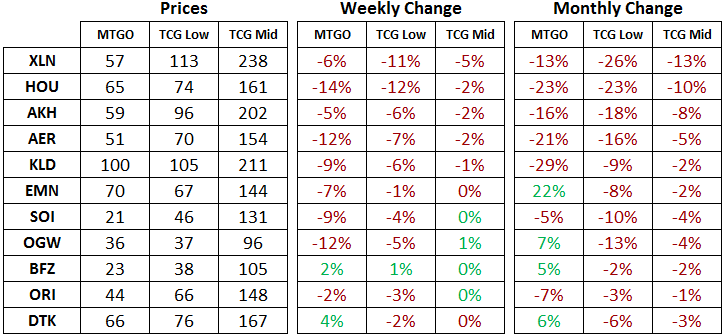
With Iconic Masters (IMA) hitting MTGO, prices have taken a dive almost across the board. A premium priced draft set has got the MTGO player base selling its cards in order to fund the next draft league entry fee.
I've taken a few spins through the IMA leagues myself, and I have to say I am impressed with the draft format. It feels like it has much better balance than Modern Masters 2017 (MM3). That set had a stronger multi-colour themed, which pushed drafting mana fixing and the most powerful gold cards. The bounce lands that show up in IMA are historically powerful in limited formats, but with multi-coloured cards being few and far between, the utility of the bounce lands is diminished. They are still good but not format defining; they are much closer in power level to the other commons in IMA, which leads to a much more interesting set to draft. It looks like IMA draft will not be converging on the best draft archetype as quickly as MM3 did.
Standard
The format looks like it has reached an equilibrium where Energy variants and Ramanup Red form the top tier and various other archetypes are looking to the scraps. Tinkering is happening around the edges, but the format looks like it has been well explored at this point. This is not a great macro perspective to be a Standard speculator, since a fluctuating metagame translates into volatility in card prices.
If you are really keen to speculate on Standard, then I would recommend long-term specs on cards that are priced close to junk. One could also make a long-term bet on uncommons from Kitesail Freebooter and Chart a Course, both of which have already seen application in Modern and both of which can be bought for 0.01 tix or less.
Modern
At this point, we are closer to being in a selling window than we are in a buying window for Modern cards. Prices on many Modern staples have ticked higher in recent weeks, and it wouldn't take much for cards like Mox Opal and Karn Liberated to hit a one-year high. Pro Tour Rivals of Ixalan will be held in Spain the first week of February 2018, so January will be a prime time to be selling to players as they build and test decks on MTGO.
Of course looking at buying cards from IMA is correct, and I'll go into detail on one card I have already been buying in the Trade of the Week right now:
Trade of the Week
For a complete look at my recent trades, please check out the portfolio.
Iconic Masters (IMA) has reprinted a number of Modern staples and supply will continue to enter the market as IMA draft leagues continue. Nevertheless, the market often presents opportunity in the early going of a set release as it grapples with how to price the reprints.
Here's a price graph from Goatbots covering the price of the Coldsnap (CSP) version of Mishra's Bauble. As you can see, the low was a little over 3 tix, but the price peak of over 30 tix suggests that this uncommon must be in low supply on MTGO. The price peak coincided with the breakout of the Death's Shadow deck in Modern earlier this year. It also shows up in Lantern Control decks as a way to get the hand size down to turn on Ensnaring Bridge.
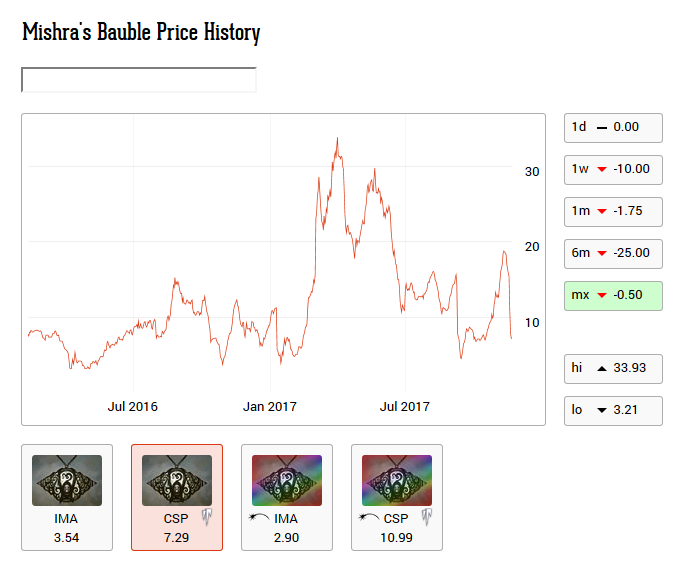
When I checked in on how IMA reprints were being priced over the weekend, Mishra's Bauble was available at around 3 tix, with Goatbots selling some copies below 3 tix and most other bots selling in the 3.0- to 3.2-tix range. Buying this card at or below the price low from the last two years seemed like a low-risk proposition, and I jumped on the opportunity.
When it comes to timing speculative purchases, it's correct to be a buyer when cards are being opened in draft. Drafters are keen to sell their cards in order to fund their next draft entry fee, and this means it pays to be a buyer. For regular sets, the best buying window is usually in the last few weeks of the draft format. But for sets like IMA, the drafting window is only three weeks long. To compound the issue of timing your buys, Masters sets are priced at a premium, so repeat drafting slows down rapidly as players run out of tix. This means that the best buying window can coincide with the first weekend of release.
Staple uncommons seem to follow this idea quite well. Check out the charts from Goatbots for Inquisition of Kozilek from Modern Masters 2017 (MM3), Dismember from Modern Masters 2015 (MM2). Inquisition of Kozilek was about 1 tix while it was being opened, but subsequently has been in the 1.5 to 2.5 tix range.
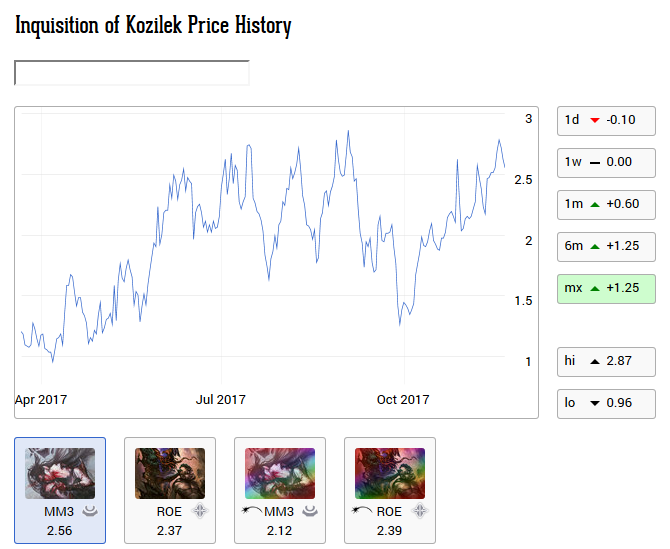
Dismember was available for less than 1 tix while it was being drafted in MM2, but it's price range a year later was 2 to 4 tix, while more recently it's been in the 3- to 5-tix range.
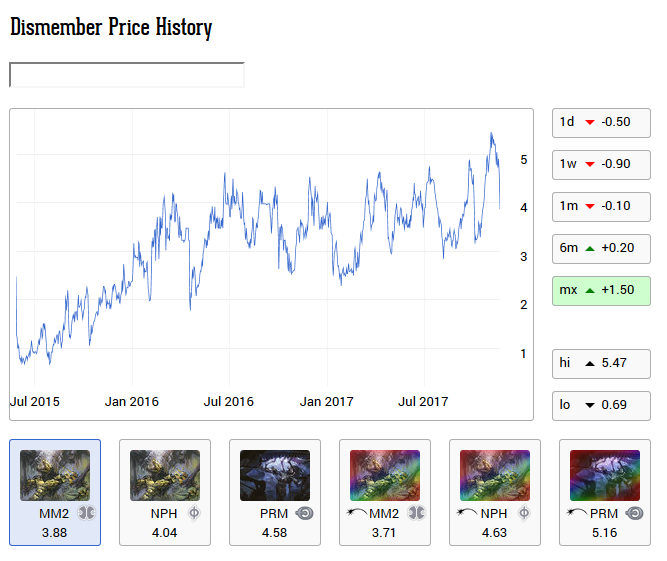
Mishra's Bauble compares well to both of these cards in that it is an uncommon from a third set and thus more lightly printed than a fall set uncommon. Like Dismember in MM2 and Inquisition of Kozilek in MM3, Mishra's Bauble is being reprinted on MTGO for the first time here. Thus, I think a return to the 4- to 8-tix range is very possible in the next six months, with a 5- to 10-tix range in the longer term also very likely.
Targeting staple uncommons early in the draft window for Masters sets looks like a great strategy going forward. Keep this in mind for the release of Masters 25 in March 2018.
And for anyone who likes to argue that MTGO players are rational and always trying to maximize their value, I offer proof by contradiction in the recent price of the CSP version of Mishra's Bauble. The week prior to the release of IMA, the price of this card was still rising, peaking at just under 19 tix. This is clear evidence of the short-term thinking prevalent in MTGO users. Players want to play their deck, and you can't play your deck without the cards you need, and this is just fine. What they are giving up in monetary value, they are getting back in their own utility. Everyone has to decide on what is worthwhile for themselves, but as long as MTGO players are not ruthless EV calculators, there will be room for savvy players to stretch their playing budget and for speculators to make a few tix.


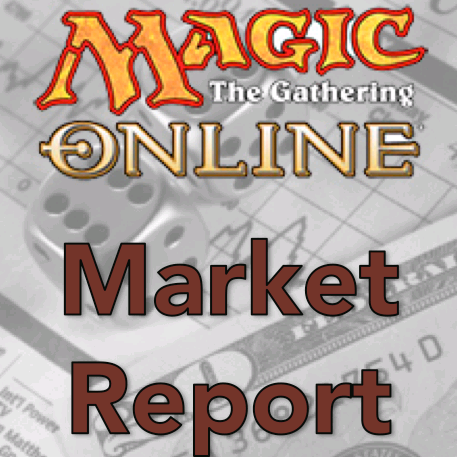




That’s not quite what I was saying on Twitter, btw. I remain more than a bit flummoxed that so many MTGO players chose to play the non-phantom IMA League over the phantom IMA League. You noted that players on MTGO aren’t sitting there calculating EV. I grant that, but there is an act of reason involved in choosing to play one swiss IMA League over another. It seems like EV should have been factoring into people’s choice a lot more than it did. Both queues offer the same sort and level of entertainment value.
Phantom has now overtaken the non-phantom league, probably because players were unhappy with losing so much money. That shift shows that players should consider the EV of events more before making decisions that they regret. Having financial awareness is important for making good choices and being happy.
Definitely! Phantom is a better choice if you want to play more and enjoy your drafts and games. But some people like the thrill of the lottery, but in this case it looks like they are quickly running out of tix, as you suggest.
Anyway, the Mishra’s Bauble situation more of a stark example of non rational behavior than anything. The big drop in price in the chart from earlier in 2017 was when IMA was spoiled in September. So, some people were acting rationally at that time, but others had either forgotten about the reprint or didn’t care, driving up the price more recently. It’s all very curious!